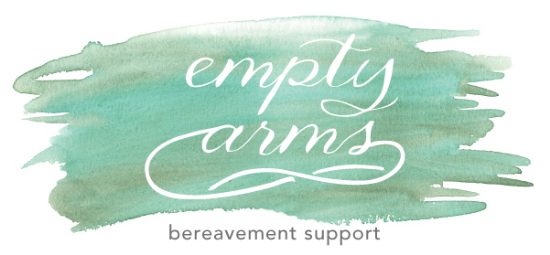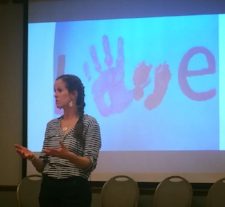Teaching is one of the most powerful things I do. When I’m faced with an audience of nurses, midwives, or other birth professionals, I have the unique opportunity to communicate the wisdom of those who have already walked the road of loss to those who will be present when another family begins this most difficult journey. I’m mindful to always present as a collaborator, and not expert: it’s important that each and every professional I reach sees Empty Arms as a resource and a partner in caring for the bereaved. It’s always my goal to make trainings relaxed and fun, and I work on a number of levels to invite professionals to settle into a conversation about what is usually considered one of the most stressful topics in the birthplace.
Last week, I was invited to Mercy Medical Center in Springfield to offer a preliminary introduction to our Peer Companion Program, which we hope to implement there. The new Nurse Manager at Mercy, Jennifer LaCasse, has a history with Empty Arms through her former position at Cooley Dickinson, and she deeply supports our work. Jen asked me to come to Mercy to introduce the Companion Program and give the nurses, especially the new ones, a sense of what to expect when a loss takes place.
When I’m teaching, I always like to assess what information participants walk in the door with. It’s helpful for me, but it’s also very helpful for them to activate what already exists in their minds when they think about loss. So before I began to speak, I asked each nurse to write on an index card what first came to mind when they imagined themselves caring for a family whose baby had died. Each nurse took a green index card and scrawled on it with a black pen, and they handed them to the front.
These nurses, you might imagine, would have an array of concerns about working with a family whose baby has died. They may have received some training in nursing school about what to expect and how to proceed, or they may have received none. I glanced through the cards and smiled to myself as I read the following:
“What do I say to grieving parents?”
“What do I say?”
“I don’t know what to say.”
“I worry about saying the wrong things- I would not want to further upset the patient or family”
“I’m afraid I won’t know what to say to comfort them. I don’t want to make things more difficult for them”
“I’m afraid of saying the wrong thing”
It was clear that the greatest fears that nurses had was simple interacting with bereaved parents. Who best then, to teach them, than a parent herself who will force them to look at her in the eye, who will talk about the difficult journey, and make it real?
So I began to talk. How do you offer a crash course in bereavement care, you may wonder? What recipe card could you possibly hand off to a nurse that would offer a step-by-step guide on how to care for a person whose baby has just died? The answer is, of course, that you can’t. Each family, and each individual, is different. Everyone carries a different story, a different history, and a different future. The only thing that is consistent among each and every family that we care for is that they all need someone they can trust, who can take care of them with kindness and compassion, and who can teach them about what people often find helpful when they find themselves in such a terrible situation. While much of nursing care can indeed be charted on a checklist, bereavement care is often about stepping out of our scrubs and into our most human shoes and offering a kind, listening ear, and guiding a family with what knowledge we have.
Through my own words, which carry my own story of loss and the stories of countless other families who have sat around the circle in Empty Arms groups, I spoke of the strong emotions that surround a person when their baby has died. Beyond sadness and grief, I described the guilt and shame and blame that often surface. I dove into the utter helplessness that families often experience, and tried to help the nurses to imagine what it would be like to be offered options when you aren’t sure what either of the choices mean. Using clear, true examples, I was able to paint a picture for them of what this moment might feel like to a family. I helped them to think through what would be right to say, and what would not feel helpful to a family. We brainstormed what the perspective might feel like to a parent, and what might feel most helpful at that time.
Overall, I encouraged them to adopt a mentality of partnering and compassion. With each family I work with, I say out loud:
“I want to help you, but I’m not sure how to do that. I’m going to do the best that I can to say the right thing and do what helps you, and I trust that you will tell me if you’re ever uncomfortable with something I say or do.”
With these words, I clearly communicate my intent to help. Every nurse that serves the bereaved can also present him or herself as a vulnerable human who is trying to do the right thing. We can all surround every statement and deed that follows that statement with our intention to help and care. And then, no matter what we say, our words can be coated with that intention.
I took lots of questions from the nurses, including what to expect a baby to look like, whether it was okay to cry, and how to organize photographers. At the end, I invited them to offer one more note card’s worth of feedback to me on the lesson if they chose.
They filed out, their 3:00 shift about to begin, and I was left hoping I’d offered them something they would use. After, I read from the following:
“I found it exceedingly helpful for you to talk about the different emotional levels that parents may go through. I also really appreciated the discussion of the humanization and normalization of the process.”
“It was so helpful to hear from you how to direct conversation with a family about their options”.
“It is so helpful to know that there’s someone I can reach out to- to help not only the parents but to guide me as a nurse, as well.”
I am so grateful that we are stretching our fingers south and will hopefully be building a strong presence at Mercy in the months to come.

